Corporate Strategy Analysis: Aldi's UK Market Performance and Change
VerifiedAdded on 2020/10/22
|28
|7876
|96
Report
AI Summary
This report provides a critical analysis of Aldi's strategic challenges and change management processes in the UK market. It begins by identifying diminishing operating profits as a key strategic issue, exploring the rationale behind the change process, and outlining the key stages involved. The analysis utilizes strategic models such as SWOT, PESTLE, Porter Five Forces, Ansoff Matrix, McKinsey 7S, and VRIO to evaluate Aldi's position and provide recommendations. The report examines challenges that threatened to derail the change process and concludes with an assessment of the end results. The introduction provides context on the competitive landscape, while the main body delves into specific issues and strategic responses. The conclusion summarizes the findings and offers insights into Aldi's future strategies. References are provided to support the analysis.
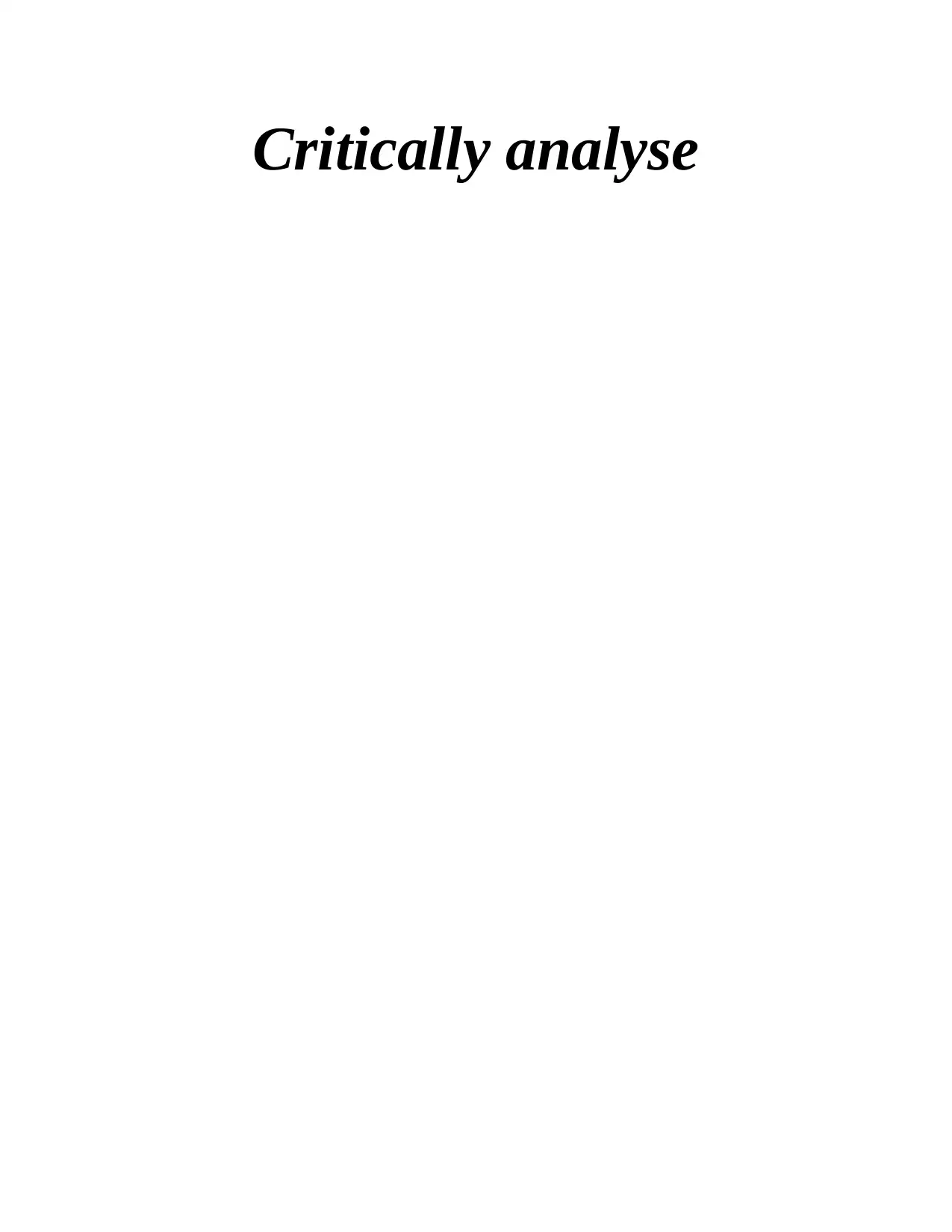
Critically analyse
Paraphrase This Document
Need a fresh take? Get an instant paraphrase of this document with our AI Paraphraser
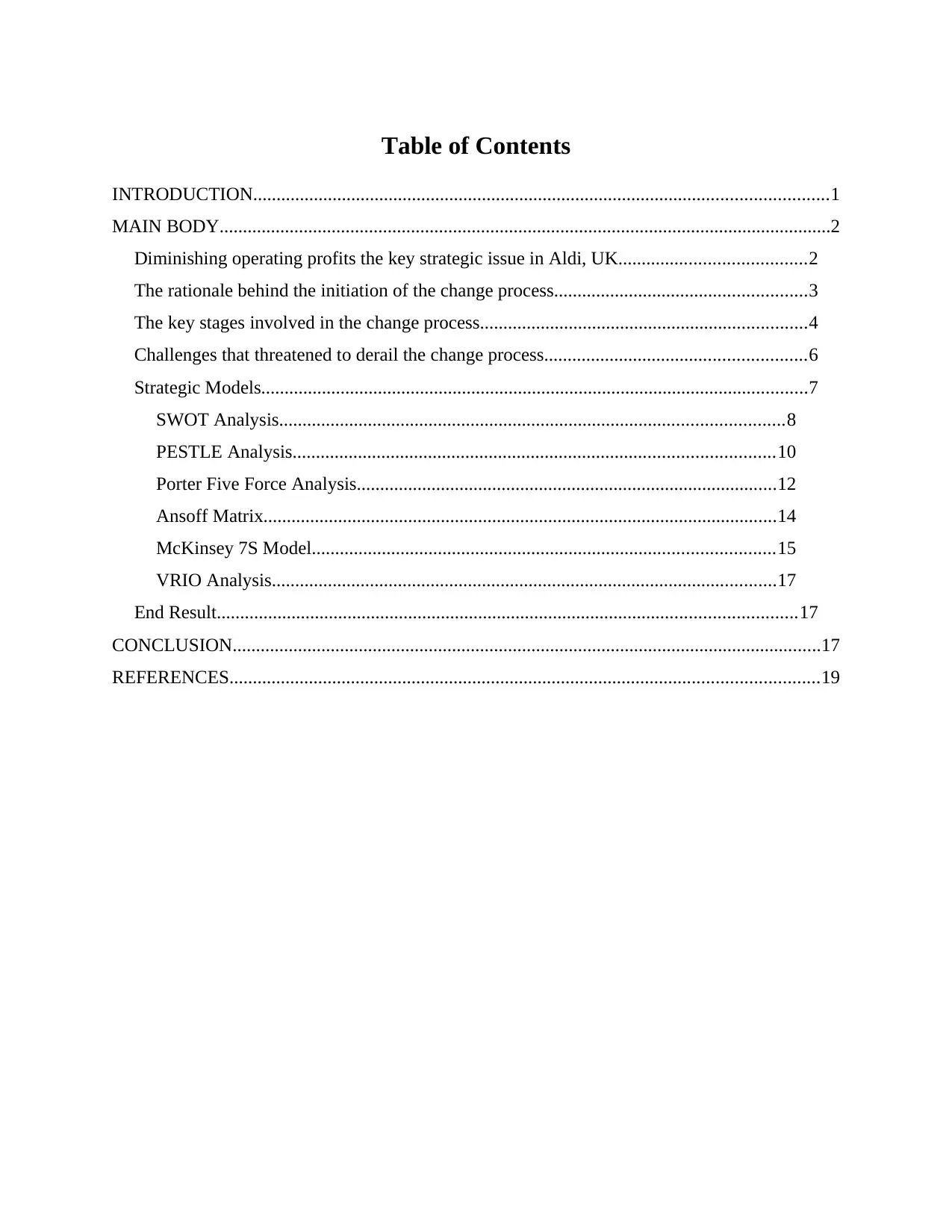
Table of Contents
INTRODUCTION...........................................................................................................................1
MAIN BODY...................................................................................................................................2
Diminishing operating profits the key strategic issue in Aldi, UK........................................2
The rationale behind the initiation of the change process......................................................3
The key stages involved in the change process......................................................................4
Challenges that threatened to derail the change process........................................................6
Strategic Models.....................................................................................................................7
SWOT Analysis............................................................................................................8
PESTLE Analysis.......................................................................................................10
Porter Five Force Analysis..........................................................................................12
Ansoff Matrix..............................................................................................................14
McKinsey 7S Model...................................................................................................15
VRIO Analysis............................................................................................................17
End Result............................................................................................................................17
CONCLUSION..............................................................................................................................17
REFERENCES..............................................................................................................................19
INTRODUCTION...........................................................................................................................1
MAIN BODY...................................................................................................................................2
Diminishing operating profits the key strategic issue in Aldi, UK........................................2
The rationale behind the initiation of the change process......................................................3
The key stages involved in the change process......................................................................4
Challenges that threatened to derail the change process........................................................6
Strategic Models.....................................................................................................................7
SWOT Analysis............................................................................................................8
PESTLE Analysis.......................................................................................................10
Porter Five Force Analysis..........................................................................................12
Ansoff Matrix..............................................................................................................14
McKinsey 7S Model...................................................................................................15
VRIO Analysis............................................................................................................17
End Result............................................................................................................................17
CONCLUSION..............................................................................................................................17
REFERENCES..............................................................................................................................19
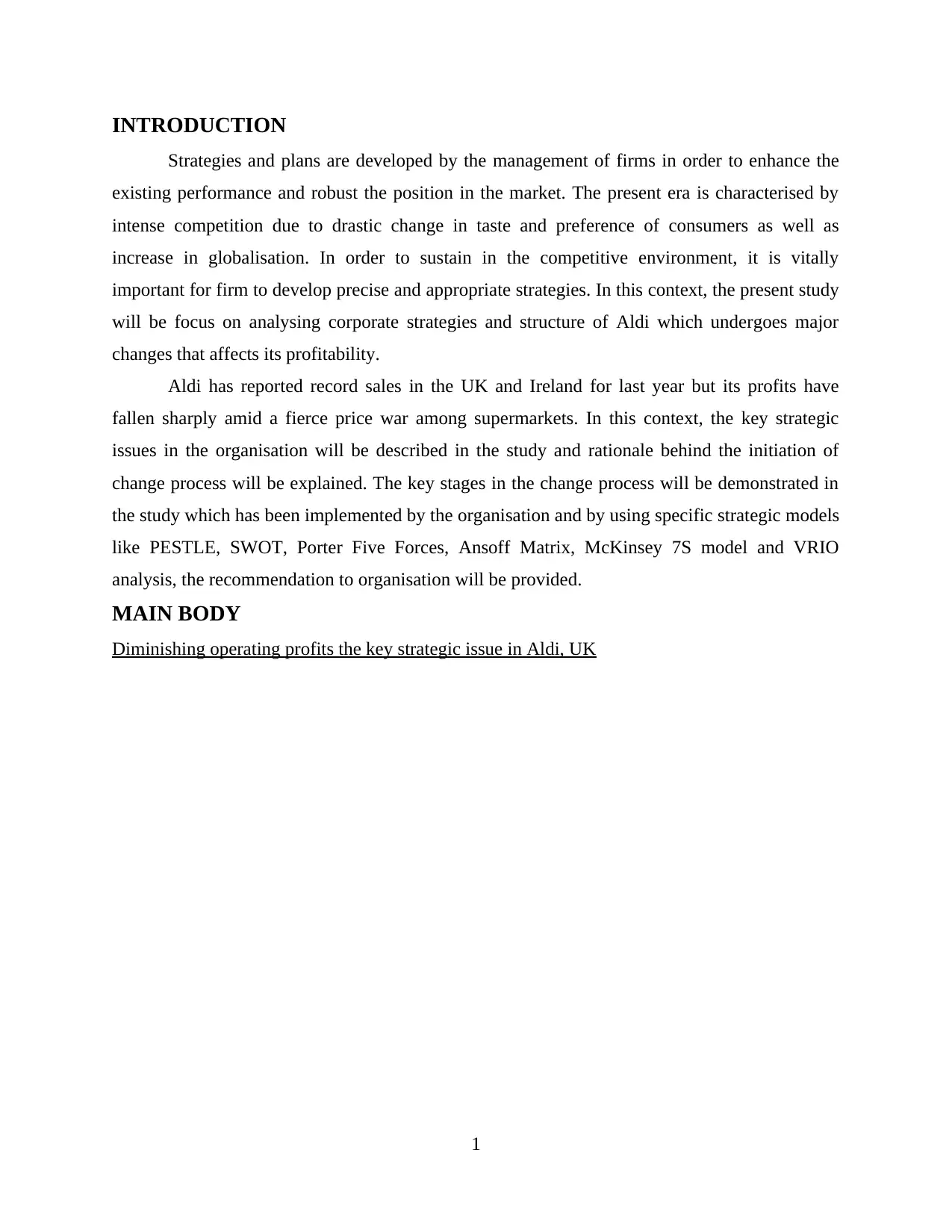
INTRODUCTION
Strategies and plans are developed by the management of firms in order to enhance the
existing performance and robust the position in the market. The present era is characterised by
intense competition due to drastic change in taste and preference of consumers as well as
increase in globalisation. In order to sustain in the competitive environment, it is vitally
important for firm to develop precise and appropriate strategies. In this context, the present study
will be focus on analysing corporate strategies and structure of Aldi which undergoes major
changes that affects its profitability.
Aldi has reported record sales in the UK and Ireland for last year but its profits have
fallen sharply amid a fierce price war among supermarkets. In this context, the key strategic
issues in the organisation will be described in the study and rationale behind the initiation of
change process will be explained. The key stages in the change process will be demonstrated in
the study which has been implemented by the organisation and by using specific strategic models
like PESTLE, SWOT, Porter Five Forces, Ansoff Matrix, McKinsey 7S model and VRIO
analysis, the recommendation to organisation will be provided.
MAIN BODY
Diminishing operating profits the key strategic issue in Aldi, UK
1
Strategies and plans are developed by the management of firms in order to enhance the
existing performance and robust the position in the market. The present era is characterised by
intense competition due to drastic change in taste and preference of consumers as well as
increase in globalisation. In order to sustain in the competitive environment, it is vitally
important for firm to develop precise and appropriate strategies. In this context, the present study
will be focus on analysing corporate strategies and structure of Aldi which undergoes major
changes that affects its profitability.
Aldi has reported record sales in the UK and Ireland for last year but its profits have
fallen sharply amid a fierce price war among supermarkets. In this context, the key strategic
issues in the organisation will be described in the study and rationale behind the initiation of
change process will be explained. The key stages in the change process will be demonstrated in
the study which has been implemented by the organisation and by using specific strategic models
like PESTLE, SWOT, Porter Five Forces, Ansoff Matrix, McKinsey 7S model and VRIO
analysis, the recommendation to organisation will be provided.
MAIN BODY
Diminishing operating profits the key strategic issue in Aldi, UK
1
⊘ This is a preview!⊘
Do you want full access?
Subscribe today to unlock all pages.

Trusted by 1+ million students worldwide
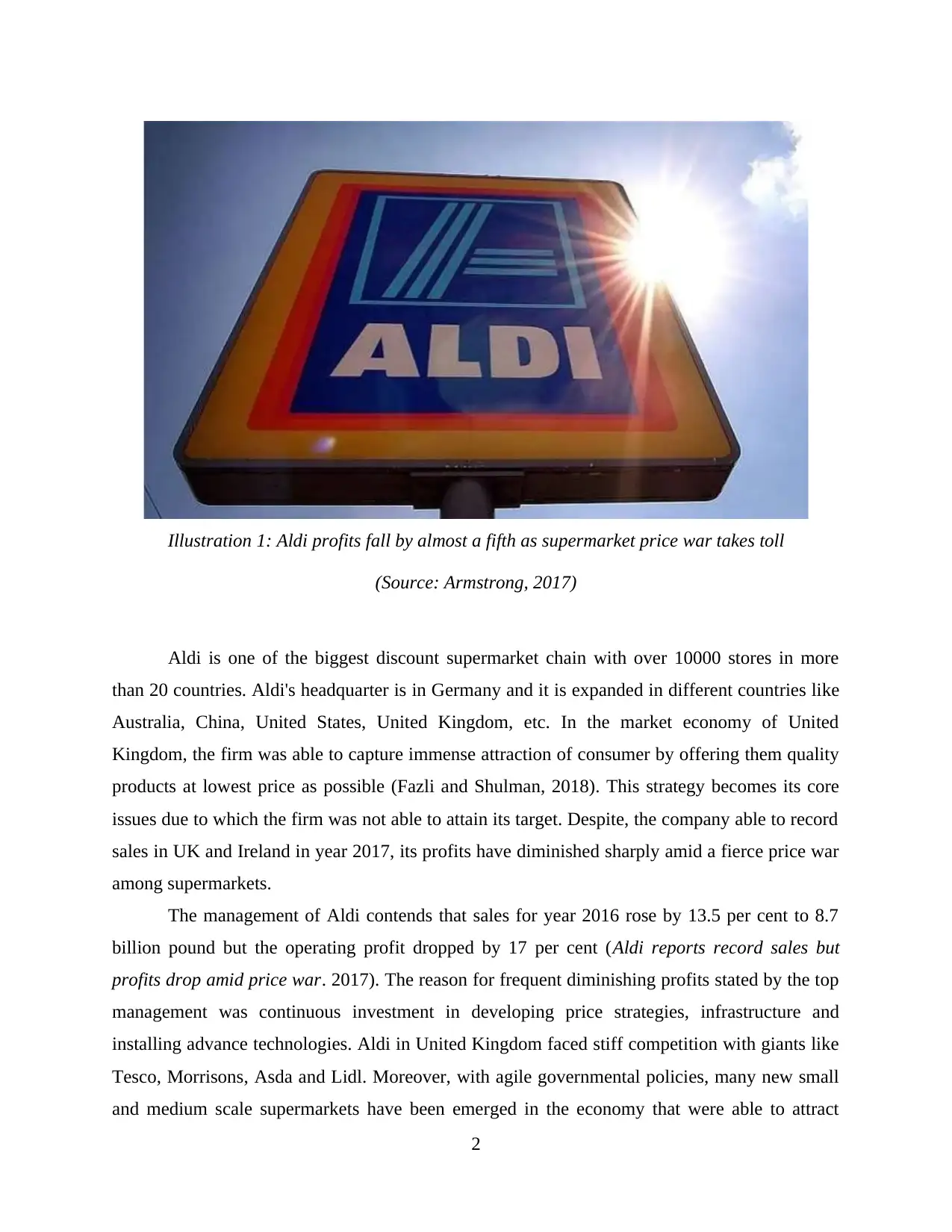
Aldi is one of the biggest discount supermarket chain with over 10000 stores in more
than 20 countries. Aldi's headquarter is in Germany and it is expanded in different countries like
Australia, China, United States, United Kingdom, etc. In the market economy of United
Kingdom, the firm was able to capture immense attraction of consumer by offering them quality
products at lowest price as possible (Fazli and Shulman, 2018). This strategy becomes its core
issues due to which the firm was not able to attain its target. Despite, the company able to record
sales in UK and Ireland in year 2017, its profits have diminished sharply amid a fierce price war
among supermarkets.
The management of Aldi contends that sales for year 2016 rose by 13.5 per cent to 8.7
billion pound but the operating profit dropped by 17 per cent (Aldi reports record sales but
profits drop amid price war. 2017). The reason for frequent diminishing profits stated by the top
management was continuous investment in developing price strategies, infrastructure and
installing advance technologies. Aldi in United Kingdom faced stiff competition with giants like
Tesco, Morrisons, Asda and Lidl. Moreover, with agile governmental policies, many new small
and medium scale supermarkets have been emerged in the economy that were able to attract
2
Illustration 1: Aldi profits fall by almost a fifth as supermarket price war takes toll
(Source: Armstrong, 2017)
than 20 countries. Aldi's headquarter is in Germany and it is expanded in different countries like
Australia, China, United States, United Kingdom, etc. In the market economy of United
Kingdom, the firm was able to capture immense attraction of consumer by offering them quality
products at lowest price as possible (Fazli and Shulman, 2018). This strategy becomes its core
issues due to which the firm was not able to attain its target. Despite, the company able to record
sales in UK and Ireland in year 2017, its profits have diminished sharply amid a fierce price war
among supermarkets.
The management of Aldi contends that sales for year 2016 rose by 13.5 per cent to 8.7
billion pound but the operating profit dropped by 17 per cent (Aldi reports record sales but
profits drop amid price war. 2017). The reason for frequent diminishing profits stated by the top
management was continuous investment in developing price strategies, infrastructure and
installing advance technologies. Aldi in United Kingdom faced stiff competition with giants like
Tesco, Morrisons, Asda and Lidl. Moreover, with agile governmental policies, many new small
and medium scale supermarkets have been emerged in the economy that were able to attract
2
Illustration 1: Aldi profits fall by almost a fifth as supermarket price war takes toll
(Source: Armstrong, 2017)
Paraphrase This Document
Need a fresh take? Get an instant paraphrase of this document with our AI Paraphraser
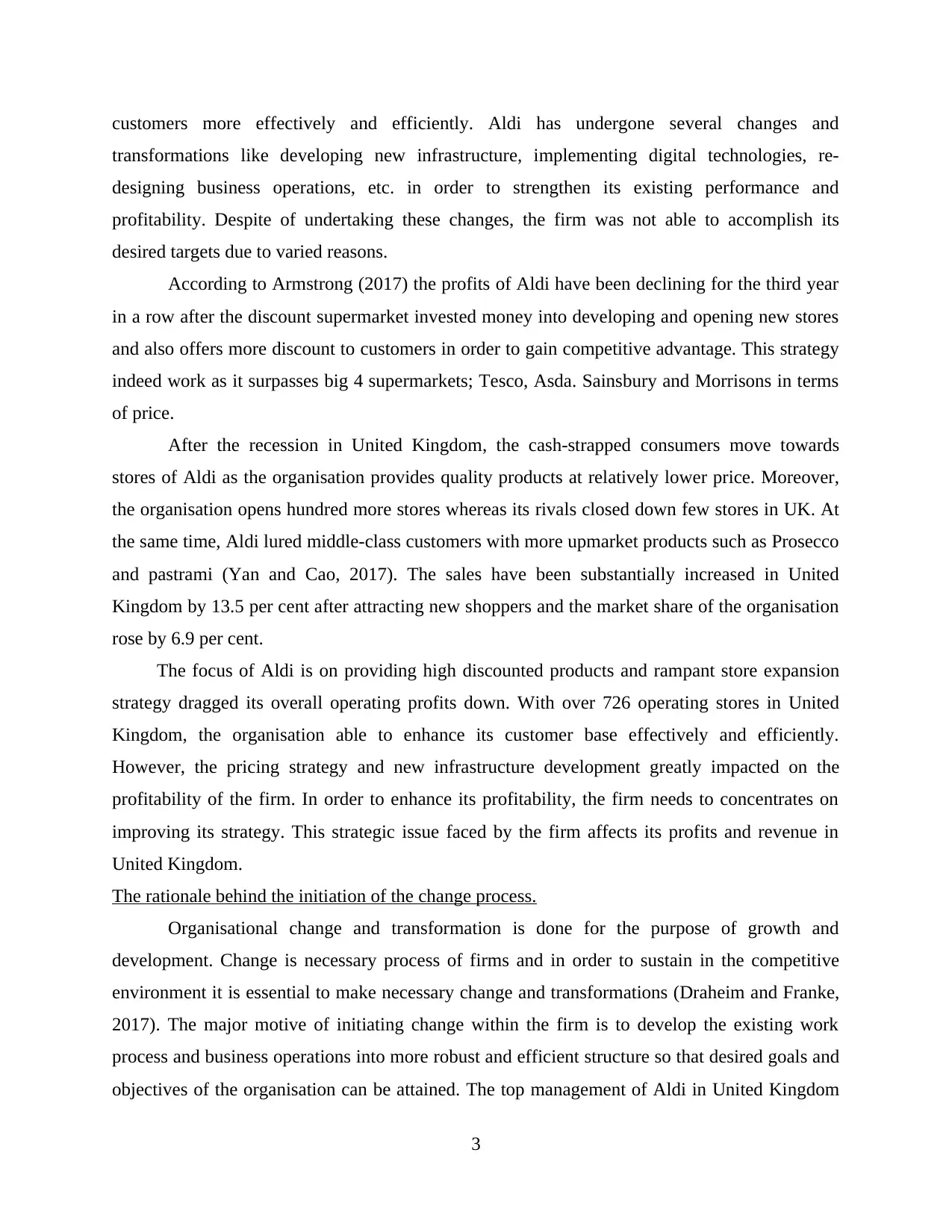
customers more effectively and efficiently. Aldi has undergone several changes and
transformations like developing new infrastructure, implementing digital technologies, re-
designing business operations, etc. in order to strengthen its existing performance and
profitability. Despite of undertaking these changes, the firm was not able to accomplish its
desired targets due to varied reasons.
According to Armstrong (2017) the profits of Aldi have been declining for the third year
in a row after the discount supermarket invested money into developing and opening new stores
and also offers more discount to customers in order to gain competitive advantage. This strategy
indeed work as it surpasses big 4 supermarkets; Tesco, Asda. Sainsbury and Morrisons in terms
of price.
After the recession in United Kingdom, the cash-strapped consumers move towards
stores of Aldi as the organisation provides quality products at relatively lower price. Moreover,
the organisation opens hundred more stores whereas its rivals closed down few stores in UK. At
the same time, Aldi lured middle-class customers with more upmarket products such as Prosecco
and pastrami (Yan and Cao, 2017). The sales have been substantially increased in United
Kingdom by 13.5 per cent after attracting new shoppers and the market share of the organisation
rose by 6.9 per cent.
The focus of Aldi is on providing high discounted products and rampant store expansion
strategy dragged its overall operating profits down. With over 726 operating stores in United
Kingdom, the organisation able to enhance its customer base effectively and efficiently.
However, the pricing strategy and new infrastructure development greatly impacted on the
profitability of the firm. In order to enhance its profitability, the firm needs to concentrates on
improving its strategy. This strategic issue faced by the firm affects its profits and revenue in
United Kingdom.
The rationale behind the initiation of the change process.
Organisational change and transformation is done for the purpose of growth and
development. Change is necessary process of firms and in order to sustain in the competitive
environment it is essential to make necessary change and transformations (Draheim and Franke,
2017). The major motive of initiating change within the firm is to develop the existing work
process and business operations into more robust and efficient structure so that desired goals and
objectives of the organisation can be attained. The top management of Aldi in United Kingdom
3
transformations like developing new infrastructure, implementing digital technologies, re-
designing business operations, etc. in order to strengthen its existing performance and
profitability. Despite of undertaking these changes, the firm was not able to accomplish its
desired targets due to varied reasons.
According to Armstrong (2017) the profits of Aldi have been declining for the third year
in a row after the discount supermarket invested money into developing and opening new stores
and also offers more discount to customers in order to gain competitive advantage. This strategy
indeed work as it surpasses big 4 supermarkets; Tesco, Asda. Sainsbury and Morrisons in terms
of price.
After the recession in United Kingdom, the cash-strapped consumers move towards
stores of Aldi as the organisation provides quality products at relatively lower price. Moreover,
the organisation opens hundred more stores whereas its rivals closed down few stores in UK. At
the same time, Aldi lured middle-class customers with more upmarket products such as Prosecco
and pastrami (Yan and Cao, 2017). The sales have been substantially increased in United
Kingdom by 13.5 per cent after attracting new shoppers and the market share of the organisation
rose by 6.9 per cent.
The focus of Aldi is on providing high discounted products and rampant store expansion
strategy dragged its overall operating profits down. With over 726 operating stores in United
Kingdom, the organisation able to enhance its customer base effectively and efficiently.
However, the pricing strategy and new infrastructure development greatly impacted on the
profitability of the firm. In order to enhance its profitability, the firm needs to concentrates on
improving its strategy. This strategic issue faced by the firm affects its profits and revenue in
United Kingdom.
The rationale behind the initiation of the change process.
Organisational change and transformation is done for the purpose of growth and
development. Change is necessary process of firms and in order to sustain in the competitive
environment it is essential to make necessary change and transformations (Draheim and Franke,
2017). The major motive of initiating change within the firm is to develop the existing work
process and business operations into more robust and efficient structure so that desired goals and
objectives of the organisation can be attained. The top management of Aldi in United Kingdom
3
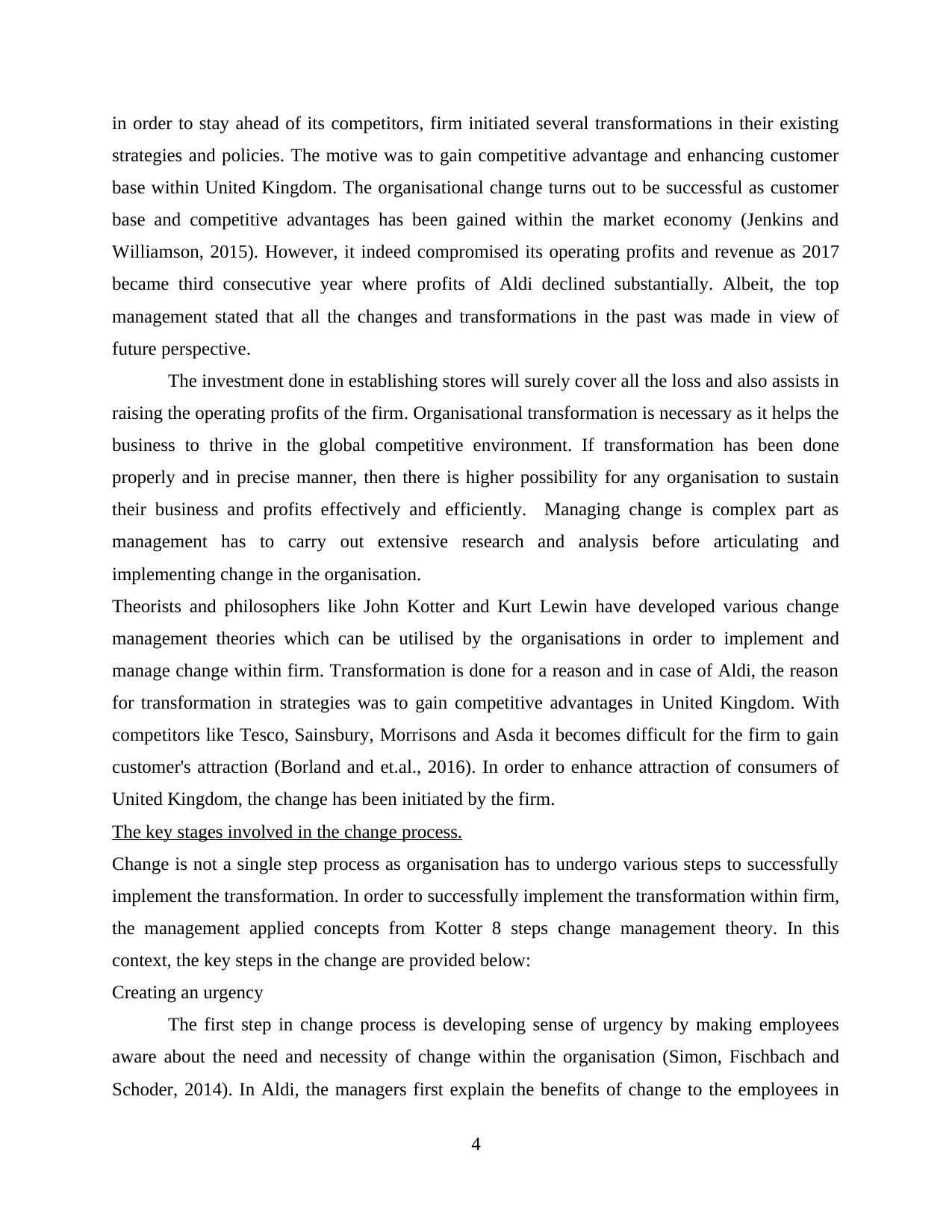
in order to stay ahead of its competitors, firm initiated several transformations in their existing
strategies and policies. The motive was to gain competitive advantage and enhancing customer
base within United Kingdom. The organisational change turns out to be successful as customer
base and competitive advantages has been gained within the market economy (Jenkins and
Williamson, 2015). However, it indeed compromised its operating profits and revenue as 2017
became third consecutive year where profits of Aldi declined substantially. Albeit, the top
management stated that all the changes and transformations in the past was made in view of
future perspective.
The investment done in establishing stores will surely cover all the loss and also assists in
raising the operating profits of the firm. Organisational transformation is necessary as it helps the
business to thrive in the global competitive environment. If transformation has been done
properly and in precise manner, then there is higher possibility for any organisation to sustain
their business and profits effectively and efficiently. Managing change is complex part as
management has to carry out extensive research and analysis before articulating and
implementing change in the organisation.
Theorists and philosophers like John Kotter and Kurt Lewin have developed various change
management theories which can be utilised by the organisations in order to implement and
manage change within firm. Transformation is done for a reason and in case of Aldi, the reason
for transformation in strategies was to gain competitive advantages in United Kingdom. With
competitors like Tesco, Sainsbury, Morrisons and Asda it becomes difficult for the firm to gain
customer's attraction (Borland and et.al., 2016). In order to enhance attraction of consumers of
United Kingdom, the change has been initiated by the firm.
The key stages involved in the change process.
Change is not a single step process as organisation has to undergo various steps to successfully
implement the transformation. In order to successfully implement the transformation within firm,
the management applied concepts from Kotter 8 steps change management theory. In this
context, the key steps in the change are provided below:
Creating an urgency
The first step in change process is developing sense of urgency by making employees
aware about the need and necessity of change within the organisation (Simon, Fischbach and
Schoder, 2014). In Aldi, the managers first explain the benefits of change to the employees in
4
strategies and policies. The motive was to gain competitive advantage and enhancing customer
base within United Kingdom. The organisational change turns out to be successful as customer
base and competitive advantages has been gained within the market economy (Jenkins and
Williamson, 2015). However, it indeed compromised its operating profits and revenue as 2017
became third consecutive year where profits of Aldi declined substantially. Albeit, the top
management stated that all the changes and transformations in the past was made in view of
future perspective.
The investment done in establishing stores will surely cover all the loss and also assists in
raising the operating profits of the firm. Organisational transformation is necessary as it helps the
business to thrive in the global competitive environment. If transformation has been done
properly and in precise manner, then there is higher possibility for any organisation to sustain
their business and profits effectively and efficiently. Managing change is complex part as
management has to carry out extensive research and analysis before articulating and
implementing change in the organisation.
Theorists and philosophers like John Kotter and Kurt Lewin have developed various change
management theories which can be utilised by the organisations in order to implement and
manage change within firm. Transformation is done for a reason and in case of Aldi, the reason
for transformation in strategies was to gain competitive advantages in United Kingdom. With
competitors like Tesco, Sainsbury, Morrisons and Asda it becomes difficult for the firm to gain
customer's attraction (Borland and et.al., 2016). In order to enhance attraction of consumers of
United Kingdom, the change has been initiated by the firm.
The key stages involved in the change process.
Change is not a single step process as organisation has to undergo various steps to successfully
implement the transformation. In order to successfully implement the transformation within firm,
the management applied concepts from Kotter 8 steps change management theory. In this
context, the key steps in the change are provided below:
Creating an urgency
The first step in change process is developing sense of urgency by making employees
aware about the need and necessity of change within the organisation (Simon, Fischbach and
Schoder, 2014). In Aldi, the managers first explain the benefits of change to the employees in
4
⊘ This is a preview!⊘
Do you want full access?
Subscribe today to unlock all pages.

Trusted by 1+ million students worldwide
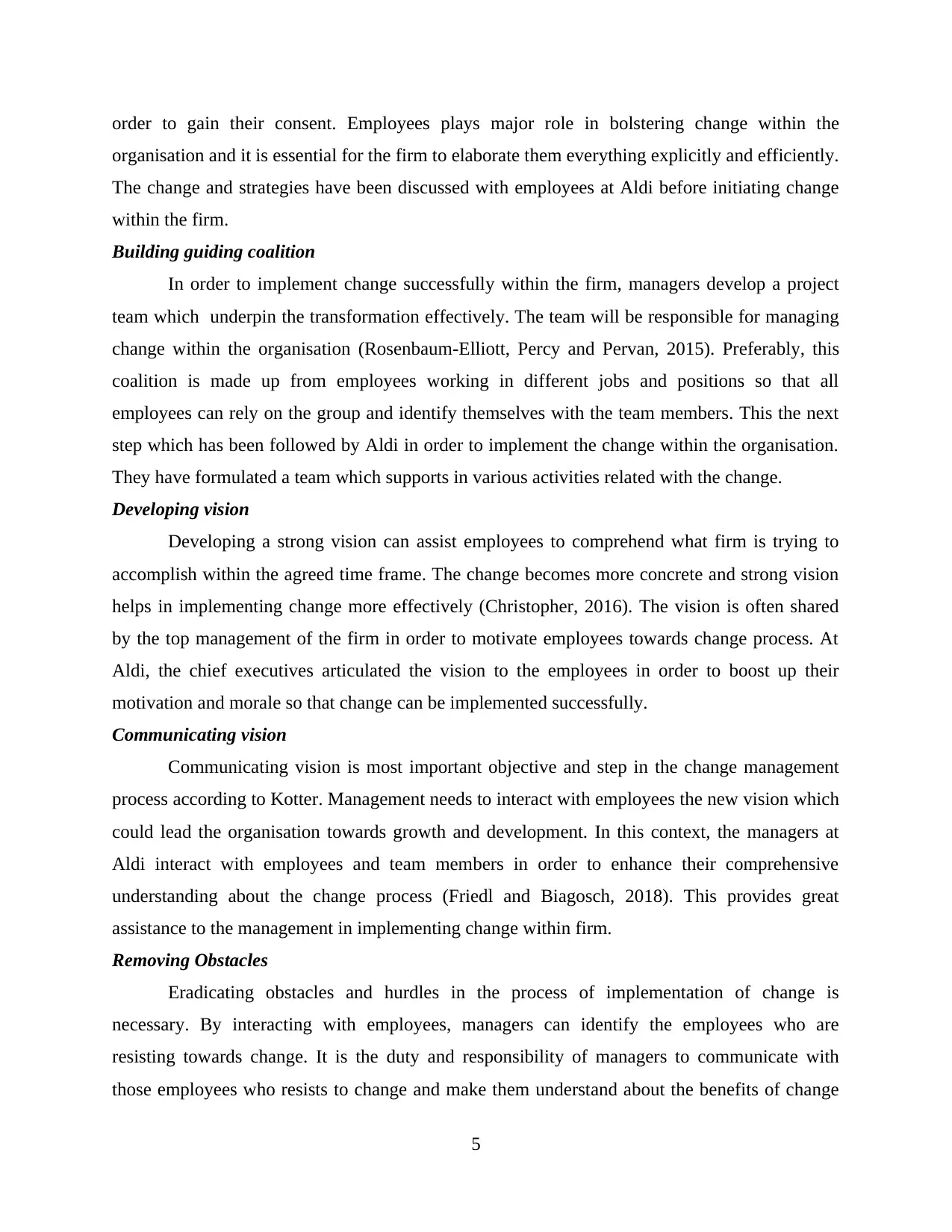
order to gain their consent. Employees plays major role in bolstering change within the
organisation and it is essential for the firm to elaborate them everything explicitly and efficiently.
The change and strategies have been discussed with employees at Aldi before initiating change
within the firm.
Building guiding coalition
In order to implement change successfully within the firm, managers develop a project
team which underpin the transformation effectively. The team will be responsible for managing
change within the organisation (Rosenbaum-Elliott, Percy and Pervan, 2015). Preferably, this
coalition is made up from employees working in different jobs and positions so that all
employees can rely on the group and identify themselves with the team members. This the next
step which has been followed by Aldi in order to implement the change within the organisation.
They have formulated a team which supports in various activities related with the change.
Developing vision
Developing a strong vision can assist employees to comprehend what firm is trying to
accomplish within the agreed time frame. The change becomes more concrete and strong vision
helps in implementing change more effectively (Christopher, 2016). The vision is often shared
by the top management of the firm in order to motivate employees towards change process. At
Aldi, the chief executives articulated the vision to the employees in order to boost up their
motivation and morale so that change can be implemented successfully.
Communicating vision
Communicating vision is most important objective and step in the change management
process according to Kotter. Management needs to interact with employees the new vision which
could lead the organisation towards growth and development. In this context, the managers at
Aldi interact with employees and team members in order to enhance their comprehensive
understanding about the change process (Friedl and Biagosch, 2018). This provides great
assistance to the management in implementing change within firm.
Removing Obstacles
Eradicating obstacles and hurdles in the process of implementation of change is
necessary. By interacting with employees, managers can identify the employees who are
resisting towards change. It is the duty and responsibility of managers to communicate with
those employees who resists to change and make them understand about the benefits of change
5
organisation and it is essential for the firm to elaborate them everything explicitly and efficiently.
The change and strategies have been discussed with employees at Aldi before initiating change
within the firm.
Building guiding coalition
In order to implement change successfully within the firm, managers develop a project
team which underpin the transformation effectively. The team will be responsible for managing
change within the organisation (Rosenbaum-Elliott, Percy and Pervan, 2015). Preferably, this
coalition is made up from employees working in different jobs and positions so that all
employees can rely on the group and identify themselves with the team members. This the next
step which has been followed by Aldi in order to implement the change within the organisation.
They have formulated a team which supports in various activities related with the change.
Developing vision
Developing a strong vision can assist employees to comprehend what firm is trying to
accomplish within the agreed time frame. The change becomes more concrete and strong vision
helps in implementing change more effectively (Christopher, 2016). The vision is often shared
by the top management of the firm in order to motivate employees towards change process. At
Aldi, the chief executives articulated the vision to the employees in order to boost up their
motivation and morale so that change can be implemented successfully.
Communicating vision
Communicating vision is most important objective and step in the change management
process according to Kotter. Management needs to interact with employees the new vision which
could lead the organisation towards growth and development. In this context, the managers at
Aldi interact with employees and team members in order to enhance their comprehensive
understanding about the change process (Friedl and Biagosch, 2018). This provides great
assistance to the management in implementing change within firm.
Removing Obstacles
Eradicating obstacles and hurdles in the process of implementation of change is
necessary. By interacting with employees, managers can identify the employees who are
resisting towards change. It is the duty and responsibility of managers to communicate with
those employees who resists to change and make them understand about the benefits of change
5
Paraphrase This Document
Need a fresh take? Get an instant paraphrase of this document with our AI Paraphraser
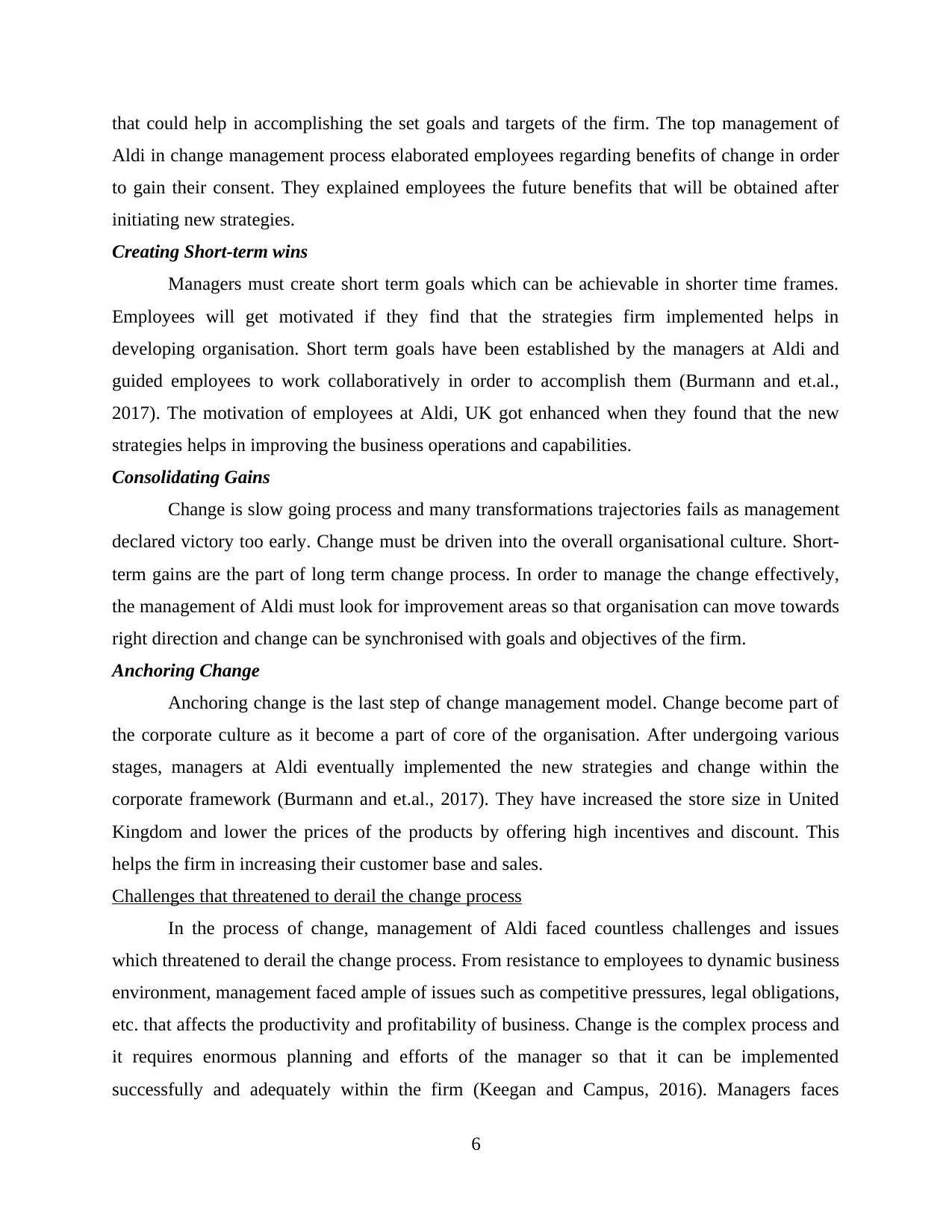
that could help in accomplishing the set goals and targets of the firm. The top management of
Aldi in change management process elaborated employees regarding benefits of change in order
to gain their consent. They explained employees the future benefits that will be obtained after
initiating new strategies.
Creating Short-term wins
Managers must create short term goals which can be achievable in shorter time frames.
Employees will get motivated if they find that the strategies firm implemented helps in
developing organisation. Short term goals have been established by the managers at Aldi and
guided employees to work collaboratively in order to accomplish them (Burmann and et.al.,
2017). The motivation of employees at Aldi, UK got enhanced when they found that the new
strategies helps in improving the business operations and capabilities.
Consolidating Gains
Change is slow going process and many transformations trajectories fails as management
declared victory too early. Change must be driven into the overall organisational culture. Short-
term gains are the part of long term change process. In order to manage the change effectively,
the management of Aldi must look for improvement areas so that organisation can move towards
right direction and change can be synchronised with goals and objectives of the firm.
Anchoring Change
Anchoring change is the last step of change management model. Change become part of
the corporate culture as it become a part of core of the organisation. After undergoing various
stages, managers at Aldi eventually implemented the new strategies and change within the
corporate framework (Burmann and et.al., 2017). They have increased the store size in United
Kingdom and lower the prices of the products by offering high incentives and discount. This
helps the firm in increasing their customer base and sales.
Challenges that threatened to derail the change process
In the process of change, management of Aldi faced countless challenges and issues
which threatened to derail the change process. From resistance to employees to dynamic business
environment, management faced ample of issues such as competitive pressures, legal obligations,
etc. that affects the productivity and profitability of business. Change is the complex process and
it requires enormous planning and efforts of the manager so that it can be implemented
successfully and adequately within the firm (Keegan and Campus, 2016). Managers faces
6
Aldi in change management process elaborated employees regarding benefits of change in order
to gain their consent. They explained employees the future benefits that will be obtained after
initiating new strategies.
Creating Short-term wins
Managers must create short term goals which can be achievable in shorter time frames.
Employees will get motivated if they find that the strategies firm implemented helps in
developing organisation. Short term goals have been established by the managers at Aldi and
guided employees to work collaboratively in order to accomplish them (Burmann and et.al.,
2017). The motivation of employees at Aldi, UK got enhanced when they found that the new
strategies helps in improving the business operations and capabilities.
Consolidating Gains
Change is slow going process and many transformations trajectories fails as management
declared victory too early. Change must be driven into the overall organisational culture. Short-
term gains are the part of long term change process. In order to manage the change effectively,
the management of Aldi must look for improvement areas so that organisation can move towards
right direction and change can be synchronised with goals and objectives of the firm.
Anchoring Change
Anchoring change is the last step of change management model. Change become part of
the corporate culture as it become a part of core of the organisation. After undergoing various
stages, managers at Aldi eventually implemented the new strategies and change within the
corporate framework (Burmann and et.al., 2017). They have increased the store size in United
Kingdom and lower the prices of the products by offering high incentives and discount. This
helps the firm in increasing their customer base and sales.
Challenges that threatened to derail the change process
In the process of change, management of Aldi faced countless challenges and issues
which threatened to derail the change process. From resistance to employees to dynamic business
environment, management faced ample of issues such as competitive pressures, legal obligations,
etc. that affects the productivity and profitability of business. Change is the complex process and
it requires enormous planning and efforts of the manager so that it can be implemented
successfully and adequately within the firm (Keegan and Campus, 2016). Managers faces
6
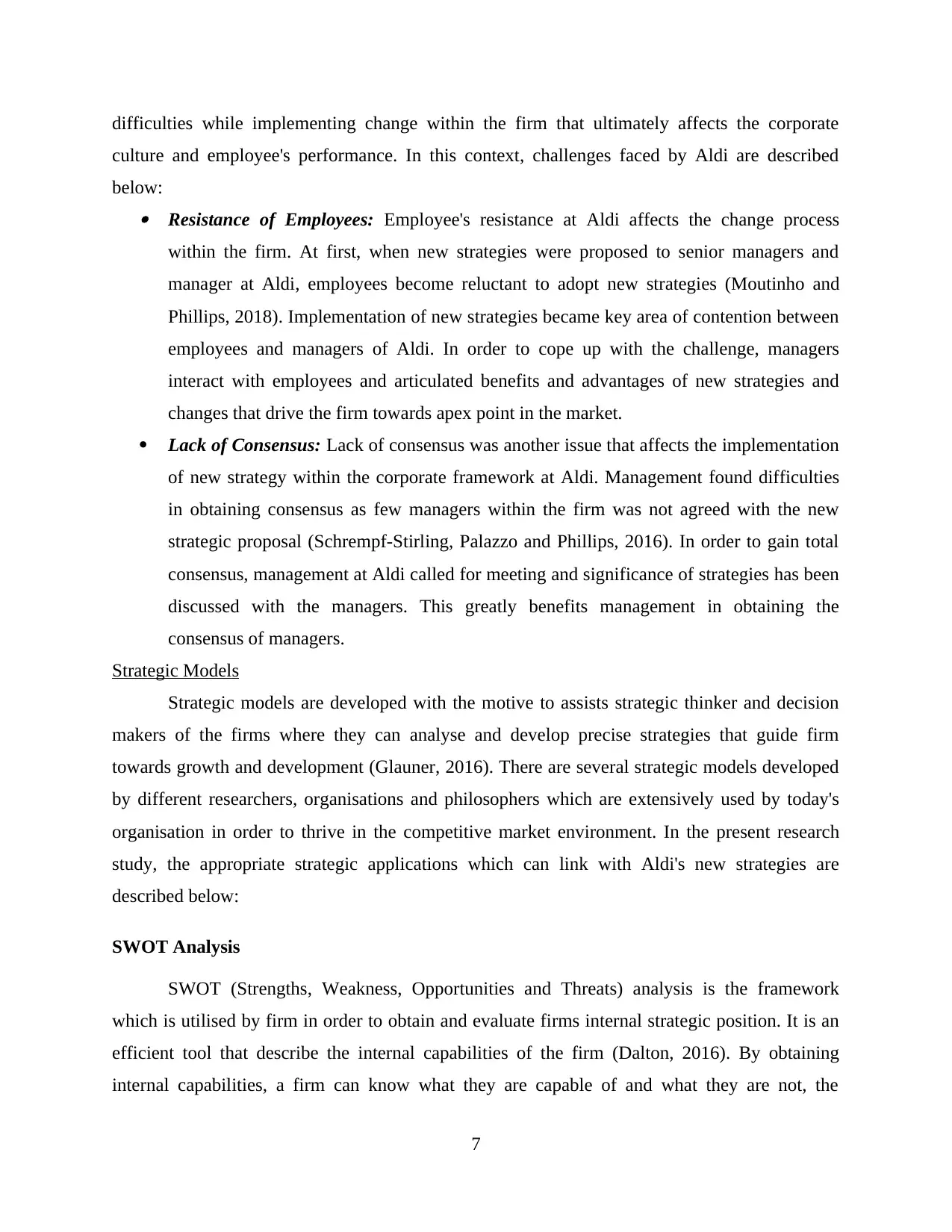
difficulties while implementing change within the firm that ultimately affects the corporate
culture and employee's performance. In this context, challenges faced by Aldi are described
below: Resistance of Employees: Employee's resistance at Aldi affects the change process
within the firm. At first, when new strategies were proposed to senior managers and
manager at Aldi, employees become reluctant to adopt new strategies (Moutinho and
Phillips, 2018). Implementation of new strategies became key area of contention between
employees and managers of Aldi. In order to cope up with the challenge, managers
interact with employees and articulated benefits and advantages of new strategies and
changes that drive the firm towards apex point in the market.
Lack of Consensus: Lack of consensus was another issue that affects the implementation
of new strategy within the corporate framework at Aldi. Management found difficulties
in obtaining consensus as few managers within the firm was not agreed with the new
strategic proposal (Schrempf-Stirling, Palazzo and Phillips, 2016). In order to gain total
consensus, management at Aldi called for meeting and significance of strategies has been
discussed with the managers. This greatly benefits management in obtaining the
consensus of managers.
Strategic Models
Strategic models are developed with the motive to assists strategic thinker and decision
makers of the firms where they can analyse and develop precise strategies that guide firm
towards growth and development (Glauner, 2016). There are several strategic models developed
by different researchers, organisations and philosophers which are extensively used by today's
organisation in order to thrive in the competitive market environment. In the present research
study, the appropriate strategic applications which can link with Aldi's new strategies are
described below:
SWOT Analysis
SWOT (Strengths, Weakness, Opportunities and Threats) analysis is the framework
which is utilised by firm in order to obtain and evaluate firms internal strategic position. It is an
efficient tool that describe the internal capabilities of the firm (Dalton, 2016). By obtaining
internal capabilities, a firm can know what they are capable of and what they are not, the
7
culture and employee's performance. In this context, challenges faced by Aldi are described
below: Resistance of Employees: Employee's resistance at Aldi affects the change process
within the firm. At first, when new strategies were proposed to senior managers and
manager at Aldi, employees become reluctant to adopt new strategies (Moutinho and
Phillips, 2018). Implementation of new strategies became key area of contention between
employees and managers of Aldi. In order to cope up with the challenge, managers
interact with employees and articulated benefits and advantages of new strategies and
changes that drive the firm towards apex point in the market.
Lack of Consensus: Lack of consensus was another issue that affects the implementation
of new strategy within the corporate framework at Aldi. Management found difficulties
in obtaining consensus as few managers within the firm was not agreed with the new
strategic proposal (Schrempf-Stirling, Palazzo and Phillips, 2016). In order to gain total
consensus, management at Aldi called for meeting and significance of strategies has been
discussed with the managers. This greatly benefits management in obtaining the
consensus of managers.
Strategic Models
Strategic models are developed with the motive to assists strategic thinker and decision
makers of the firms where they can analyse and develop precise strategies that guide firm
towards growth and development (Glauner, 2016). There are several strategic models developed
by different researchers, organisations and philosophers which are extensively used by today's
organisation in order to thrive in the competitive market environment. In the present research
study, the appropriate strategic applications which can link with Aldi's new strategies are
described below:
SWOT Analysis
SWOT (Strengths, Weakness, Opportunities and Threats) analysis is the framework
which is utilised by firm in order to obtain and evaluate firms internal strategic position. It is an
efficient tool that describe the internal capabilities of the firm (Dalton, 2016). By obtaining
internal capabilities, a firm can know what they are capable of and what they are not, the
7
⊘ This is a preview!⊘
Do you want full access?
Subscribe today to unlock all pages.

Trusted by 1+ million students worldwide
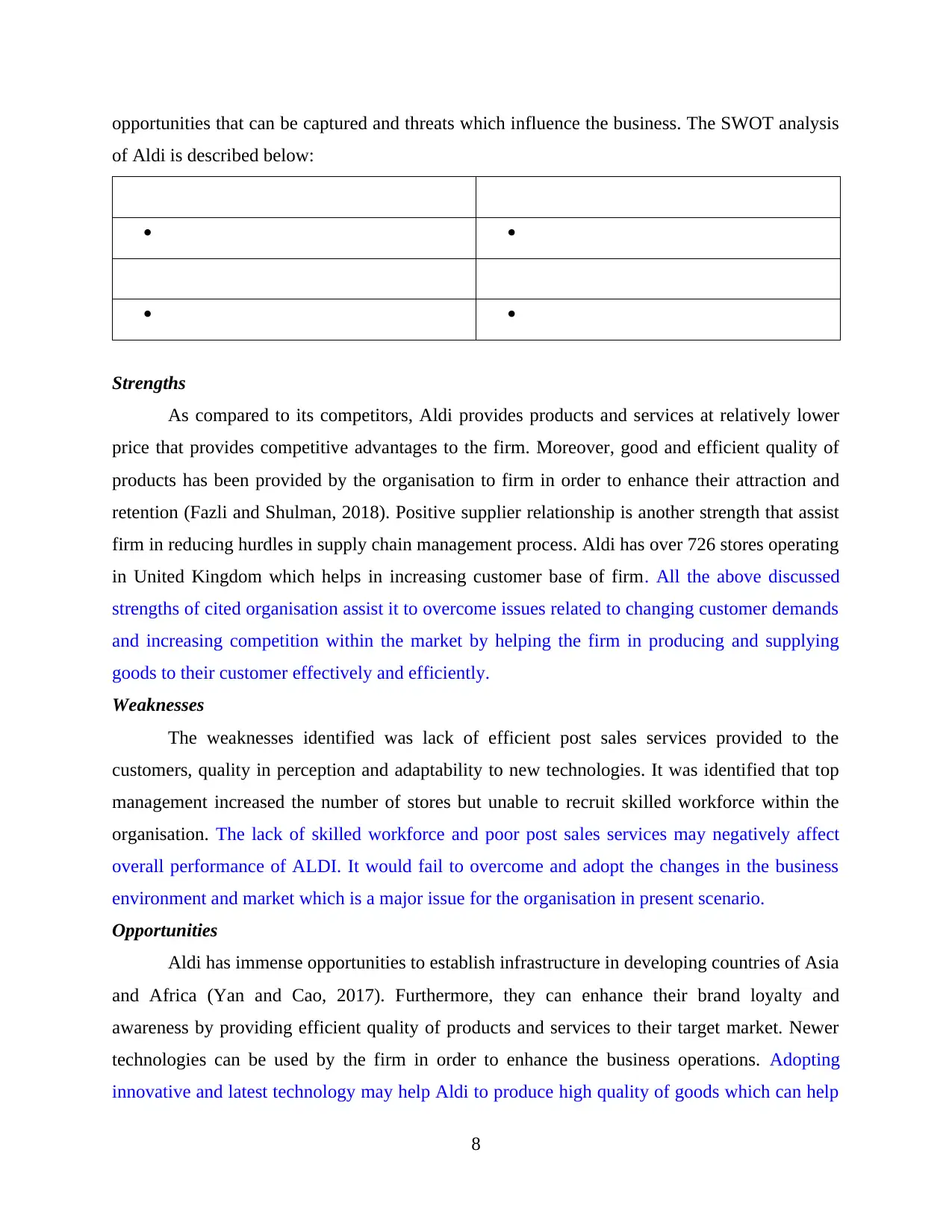
opportunities that can be captured and threats which influence the business. The SWOT analysis
of Aldi is described below:
Strengths
As compared to its competitors, Aldi provides products and services at relatively lower
price that provides competitive advantages to the firm. Moreover, good and efficient quality of
products has been provided by the organisation to firm in order to enhance their attraction and
retention (Fazli and Shulman, 2018). Positive supplier relationship is another strength that assist
firm in reducing hurdles in supply chain management process. Aldi has over 726 stores operating
in United Kingdom which helps in increasing customer base of firm. All the above discussed
strengths of cited organisation assist it to overcome issues related to changing customer demands
and increasing competition within the market by helping the firm in producing and supplying
goods to their customer effectively and efficiently.
Weaknesses
The weaknesses identified was lack of efficient post sales services provided to the
customers, quality in perception and adaptability to new technologies. It was identified that top
management increased the number of stores but unable to recruit skilled workforce within the
organisation. The lack of skilled workforce and poor post sales services may negatively affect
overall performance of ALDI. It would fail to overcome and adopt the changes in the business
environment and market which is a major issue for the organisation in present scenario.
Opportunities
Aldi has immense opportunities to establish infrastructure in developing countries of Asia
and Africa (Yan and Cao, 2017). Furthermore, they can enhance their brand loyalty and
awareness by providing efficient quality of products and services to their target market. Newer
technologies can be used by the firm in order to enhance the business operations. Adopting
innovative and latest technology may help Aldi to produce high quality of goods which can help
8
of Aldi is described below:
Strengths
As compared to its competitors, Aldi provides products and services at relatively lower
price that provides competitive advantages to the firm. Moreover, good and efficient quality of
products has been provided by the organisation to firm in order to enhance their attraction and
retention (Fazli and Shulman, 2018). Positive supplier relationship is another strength that assist
firm in reducing hurdles in supply chain management process. Aldi has over 726 stores operating
in United Kingdom which helps in increasing customer base of firm. All the above discussed
strengths of cited organisation assist it to overcome issues related to changing customer demands
and increasing competition within the market by helping the firm in producing and supplying
goods to their customer effectively and efficiently.
Weaknesses
The weaknesses identified was lack of efficient post sales services provided to the
customers, quality in perception and adaptability to new technologies. It was identified that top
management increased the number of stores but unable to recruit skilled workforce within the
organisation. The lack of skilled workforce and poor post sales services may negatively affect
overall performance of ALDI. It would fail to overcome and adopt the changes in the business
environment and market which is a major issue for the organisation in present scenario.
Opportunities
Aldi has immense opportunities to establish infrastructure in developing countries of Asia
and Africa (Yan and Cao, 2017). Furthermore, they can enhance their brand loyalty and
awareness by providing efficient quality of products and services to their target market. Newer
technologies can be used by the firm in order to enhance the business operations. Adopting
innovative and latest technology may help Aldi to produce high quality of goods which can help
8
Paraphrase This Document
Need a fresh take? Get an instant paraphrase of this document with our AI Paraphraser
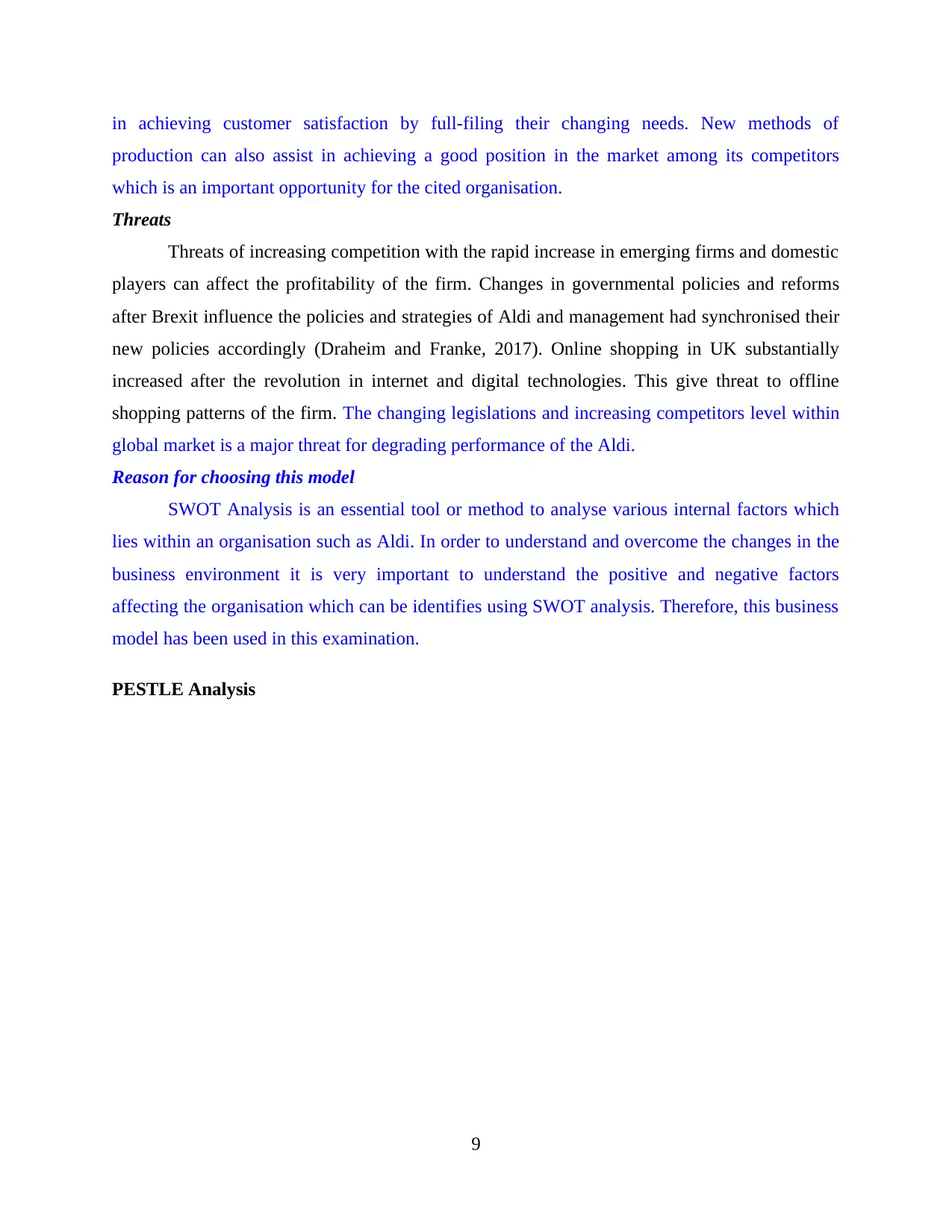
in achieving customer satisfaction by full-filing their changing needs. New methods of
production can also assist in achieving a good position in the market among its competitors
which is an important opportunity for the cited organisation.
Threats
Threats of increasing competition with the rapid increase in emerging firms and domestic
players can affect the profitability of the firm. Changes in governmental policies and reforms
after Brexit influence the policies and strategies of Aldi and management had synchronised their
new policies accordingly (Draheim and Franke, 2017). Online shopping in UK substantially
increased after the revolution in internet and digital technologies. This give threat to offline
shopping patterns of the firm. The changing legislations and increasing competitors level within
global market is a major threat for degrading performance of the Aldi.
Reason for choosing this model
SWOT Analysis is an essential tool or method to analyse various internal factors which
lies within an organisation such as Aldi. In order to understand and overcome the changes in the
business environment it is very important to understand the positive and negative factors
affecting the organisation which can be identifies using SWOT analysis. Therefore, this business
model has been used in this examination.
PESTLE Analysis
9
production can also assist in achieving a good position in the market among its competitors
which is an important opportunity for the cited organisation.
Threats
Threats of increasing competition with the rapid increase in emerging firms and domestic
players can affect the profitability of the firm. Changes in governmental policies and reforms
after Brexit influence the policies and strategies of Aldi and management had synchronised their
new policies accordingly (Draheim and Franke, 2017). Online shopping in UK substantially
increased after the revolution in internet and digital technologies. This give threat to offline
shopping patterns of the firm. The changing legislations and increasing competitors level within
global market is a major threat for degrading performance of the Aldi.
Reason for choosing this model
SWOT Analysis is an essential tool or method to analyse various internal factors which
lies within an organisation such as Aldi. In order to understand and overcome the changes in the
business environment it is very important to understand the positive and negative factors
affecting the organisation which can be identifies using SWOT analysis. Therefore, this business
model has been used in this examination.
PESTLE Analysis
9
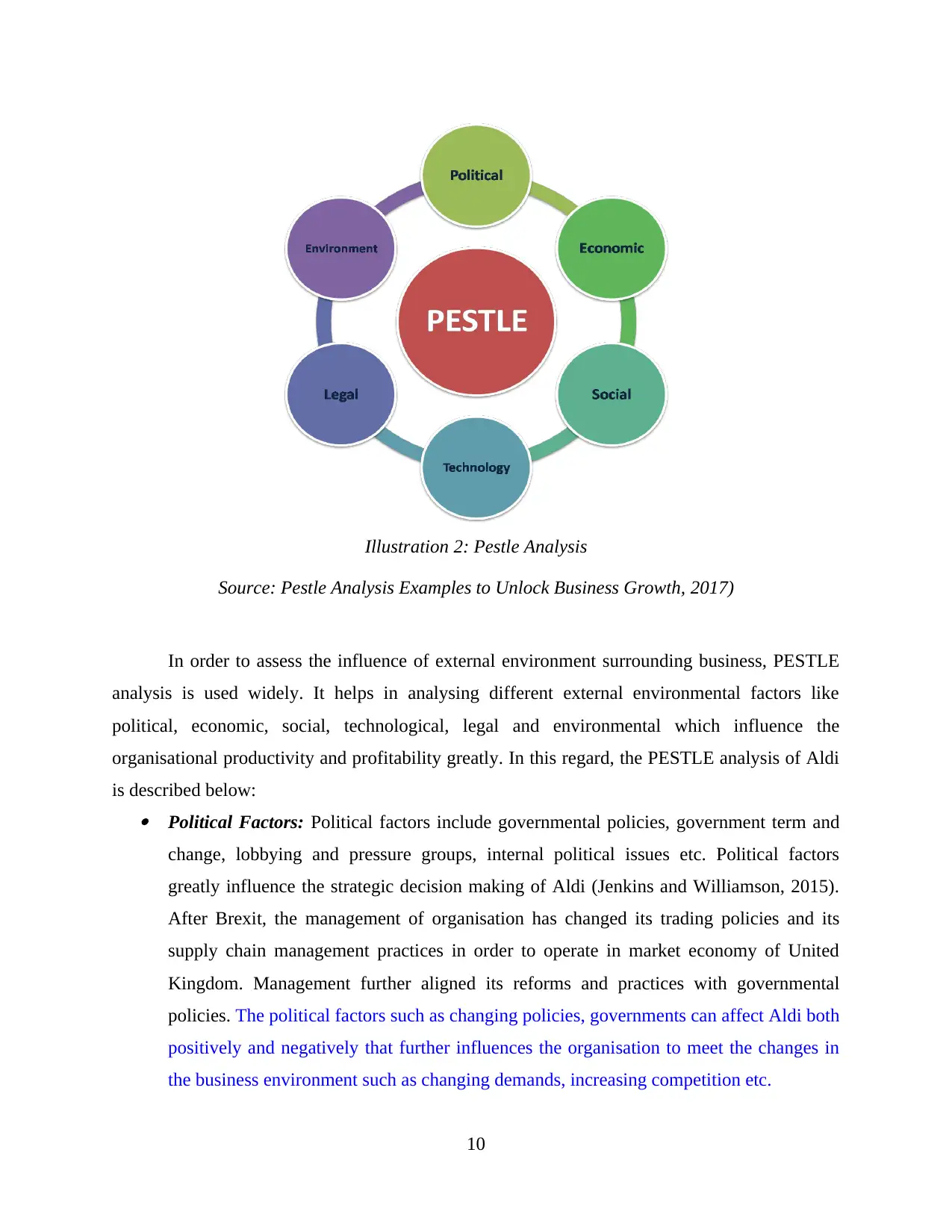
In order to assess the influence of external environment surrounding business, PESTLE
analysis is used widely. It helps in analysing different external environmental factors like
political, economic, social, technological, legal and environmental which influence the
organisational productivity and profitability greatly. In this regard, the PESTLE analysis of Aldi
is described below: Political Factors: Political factors include governmental policies, government term and
change, lobbying and pressure groups, internal political issues etc. Political factors
greatly influence the strategic decision making of Aldi (Jenkins and Williamson, 2015).
After Brexit, the management of organisation has changed its trading policies and its
supply chain management practices in order to operate in market economy of United
Kingdom. Management further aligned its reforms and practices with governmental
policies. The political factors such as changing policies, governments can affect Aldi both
positively and negatively that further influences the organisation to meet the changes in
the business environment such as changing demands, increasing competition etc.
10
Illustration 2: Pestle Analysis
Source: Pestle Analysis Examples to Unlock Business Growth, 2017)
analysis is used widely. It helps in analysing different external environmental factors like
political, economic, social, technological, legal and environmental which influence the
organisational productivity and profitability greatly. In this regard, the PESTLE analysis of Aldi
is described below: Political Factors: Political factors include governmental policies, government term and
change, lobbying and pressure groups, internal political issues etc. Political factors
greatly influence the strategic decision making of Aldi (Jenkins and Williamson, 2015).
After Brexit, the management of organisation has changed its trading policies and its
supply chain management practices in order to operate in market economy of United
Kingdom. Management further aligned its reforms and practices with governmental
policies. The political factors such as changing policies, governments can affect Aldi both
positively and negatively that further influences the organisation to meet the changes in
the business environment such as changing demands, increasing competition etc.
10
Illustration 2: Pestle Analysis
Source: Pestle Analysis Examples to Unlock Business Growth, 2017)
⊘ This is a preview!⊘
Do you want full access?
Subscribe today to unlock all pages.

Trusted by 1+ million students worldwide
1 out of 28
Related Documents
Your All-in-One AI-Powered Toolkit for Academic Success.
+13062052269
info@desklib.com
Available 24*7 on WhatsApp / Email
![[object Object]](/_next/static/media/star-bottom.7253800d.svg)
Unlock your academic potential
Copyright © 2020–2025 A2Z Services. All Rights Reserved. Developed and managed by ZUCOL.


